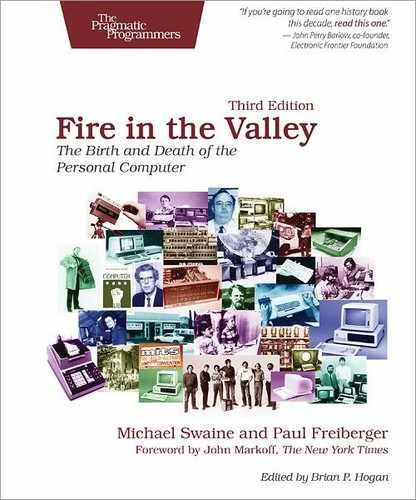Electric Pencil
When I started doing business, I had an unlisted phone number.
–Michael Shrayer, software pioneer and camera operator for Candid Camera
In the fall of 1975 at one of the early meetings of the Southern California Computer Society, a guest at the meeting had a special present for the attendees. Bob Marsh offered up a copy of Processor Technology’s public-domain software package called Software Package One. It was a collection of programmers’ programs—tools to make writing and modifying programs easier. Marsh told everyone, “Here you are, guys; enjoy it.”
An Editor for Developers
In the opinion of software developer Michael Shrayer, Software Package One was the most important product then in existence because it effectively enabled people to write software. Shrayer, a self-admitted “laid-back sort,” had moved from New York to California several years earlier. He had tired of his hectic life in the commercial-film world where, among other jobs, he worked as a camera operator for Allen Funt’s Candid Camera. In the middle of shooting a soft-drink commercial, Shrayer realized that the rat race was no longer worth it. After moving to California, he hooked up with the Southern California Computer Society, where he discovered Software Package One.

Figure 42. Michael Shrayer Shrayer started doing business with an unlisted phone number. Here he shows off his pioneering word-processing program, Electric Pencil.
(Courtesy of Paul Freiberger)
Shrayer was not fully satisfied with the editor portion of the software package and thought he could come up with something better. He created Extended Software Package 1 (ESP-1) and the beginnings of a pioneering software firm. Other computer hobbyists, in numbers that amazed Shrayer, wanted to buy the ESP-1 program. In most cases, he had to reconfigure the program for each customer’s particular machine. Almost overnight, the laid-back New Yorker found himself in a brand-new rat race.
Shrayer was soon making enough money to live on. It was a nice hobby, and remunerative, and he found that he liked to program. He gathered with other members of the club and talked endlessly about computers. He filled orders for copies of ESP-1. He was having fun.
Shrayer’s next idea proved to have a significant impact on the nascent software industry. Tired of having to type out the documentation for his assembler on a manual typewriter, Shrayer decided to use his Executor software (an upgrade of ESP-1) to get the job done. He asked himself, why not use the computer to type a manual? Nothing close to a word processor was available yet. Without having even heard the term “word processor,” Shrayer set about to invent one.
Ahead of His Time
By Christmas 1976, after nearly a year of work, Shrayer’s Electric Pencil was ready. Although first written on the Altair, Electric Pencil gained acclaim on Proc Tech’s Sol. “The Pencil,” as it became known, was soon selling quickly. The former camera jockey called his company Michael Shrayer Software, a decision he later regretted because it publicized his name so widely that it ruined his privacy. Nevertheless, at the outset of his new enterprise, he visited computer clubs to talk about his program and enjoyed the admiration heaped upon him.
The popularity of Electric Pencil was so great that it created a buyer demand that it be on all microcomputers then available. Shrayer spent much of his time rewriting the program for different systems. Not only did each kind of computer require a different version, but so did each kind of printer or terminal. Moreover, Shrayer was constantly upgrading Electric Pencil’s capabilities. In all, he wrote about 78 different versions.
Had Shrayer been a more experienced programmer, he might have made the program easier to rework. Had he been a more experienced businessperson, he might have sold it in a more organized fashion. But Shrayer was neither, and the rewriting devoured his time, and sales were often limited to single orders by mail. Shrayer grew tired of Electric Pencil and became irritated that it was growing into a serious business that demanded more of his time. He hired programmers to write some of the new Pencil versions for him.
Shrayer’s experience demonstrated that in 1977 hardware manufacturers still didn’t recognize the importance of software, perhaps thinking that the marketplace would remain dominated by hobbyists. In any case, no hardware companies were willing to pay Shrayer to adapt The Pencil to their machines, although they certainly wouldn’t complain if he did so on his own.
Just as Kildall, Eubanks, Gates, and Allen had done before him, Michael Shrayer proceeded according to his own whims and wishes and wrote programs for whatever machines he wanted to. When he eventually lost his enthusiasm for the whole enterprise, he went back to the quiet life he had found on leaving the film world.
Years later, Electric Pencil seemed to have become the program that would not die. Thousands of personal-computer owners continued to use it on machines such as the North Stars and Radio Shack TRS-80s. Shrayer had broken new ground and empowered nontechnical people to use personal computers to perform practical tasks. The market was expanding.
